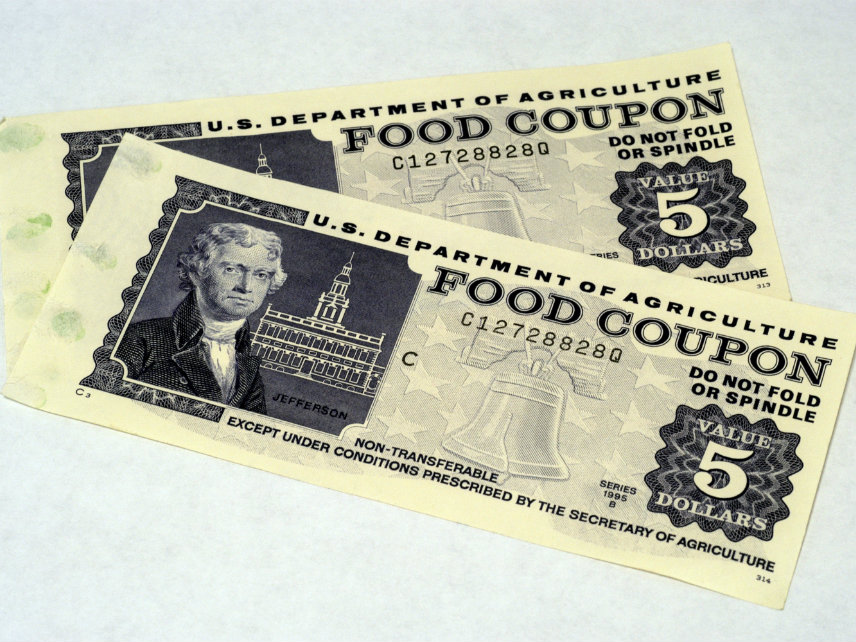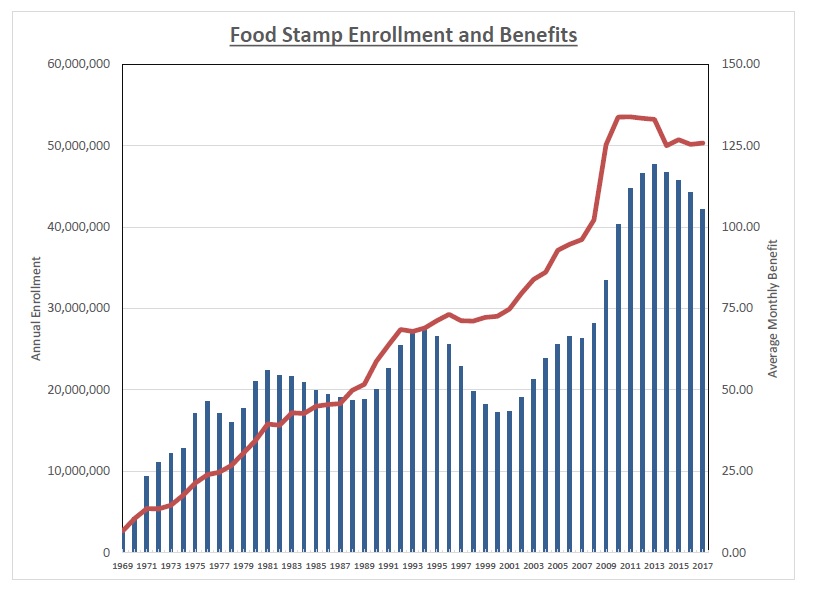Trump's Food Stamp Overhaul Sounds Like a Boondoggle Waiting to Happen
And, weirdly, grocery store cronyism might be the thing that stops it.

As part of the budget proposal unveiled earlier this week, the Trump administration is calling for a radical overhaul of so-called "food stamps" that would have the U.S. Department of Agriculture shipping boxes of nonperishable food to low-income Americans every month.
Think Amazon Prime, but for terrible canned food selected by bureaucrats.
The problem here isn't the general idea of reforming the Supplemental Nutritional Assistance Program (SNAP). The Government Accountability Office has raised red flags about abuse of SNAP benefits, and the U.S. Department of Agricuture's inspector general says "the magnitude of program abuse due to recipient fraud is unknown," in part because states do not have uniform reporting requirements about beneficiaries. There's also a glorious history of outrage journalism focused on particularly egregious abuses of the SNAP system, like the infamous California surfer dude who told Fox News in 2013 that he was eating lobster on the taxpayers' dime. And while those stories may be more anecdotal than systematic, there's also plenty of run-of-the-mill government waste in SNAP.
Meanwhile, spending on food stamps doubled under George W. Bush, despite the fact that most of his presidency saw relatively low unemployment, and it continued to climb under Barack Obama, thanks to the Great Recession and the stimulus bill, which eased income requirements for recipients. Enrollment in SNAP has fallen slightly since peaking in 2013, but there were still more than 42 million Americans getting food stamps in 2017, up from just 17 million at the turn of the century. The average benefit is about $125 per month.
But Trump's "America's Harvest Box" proposal is a boondoggle waiting to happen. There are many, many good questions about how the program would actually work, and very few answers in the budget proposal. Even if the USDA figures out how to deliver food to the homeless or account for possible nut allergies, there's still the bigger fundamental question of how the government is going to pack and ship hundreds of millions of food boxes each year.
The USDA claims the America's Harvest Box system will save about $129 billion over 10 years. That may sound like a lot, but USDA spokesman Tim Murtaugh told Politico it "does not include shipping door-to-door for all recipients," which, you know, seems like a pretty big expense to leave out. Making 5 billion food shipments over the next 10 years—that's 42 million people, times 12 shipments per year, times 10 years—will surely wipe out a good chunk of those savings. It may well wipe out all of them.

On a fundamental level, SNAP benefits are a voucher system—they distribute public benefits without having the government directly involved in the distribution. This is generally a better way to go about providing welfare and other government services (like schools!) because it allows the market to do the work of providing goods and services to consumers, while the government's role is reduced to merely helping fund the operation. They're not perfect, of course, as the history of waste and abuse in the SNAP system demonstrates. Voucher systems also require bureaucratic oversight—SNAP spent more than $4.3 billion on "administrative costs" in 2017—that consume tax dollars without helping anyone, and they create rent-seeking opportunities for the businesses that collect government voucher money in exchange for providing goods and services to the needy.
In fact, that latter phenomenon is likely to be the thing that stops the administration from implementing its plan to replace SNAP with these weirdly paternalistic government-issued food boxes.
Jennifer Hatcher, chief public policy officer for the Food Marketing Institute, which represents grocery stores and other retailers that sell food, has already declared that the food box proposal "would increase costs in other areas that would negate any savings." Her institute warns that government-delivered food boxes would be far less efficient than the current setup.
There are two things happening here. First, grocery stores are protecting their own bottom lines. They make billions of dollars each year from SNAP recipients, and they understandably don't want to see those people getting their food somewhere else. This sort of behavior is exactly why reforming welfare and entitlement programs is so politically difficult. Grocery stores like SNAP, hospitals like Medicaid, and so on. Regardless of how you feel about the administration's plan to radically alter the SNAP program, that inertia presents a real problem for instituting changes.
Second, well, the grocery stores aren't exactly wrong about the inefficiency thing.
Prosperous countries shouldn't allow people to starve to death in the streets, so the debate over SNAP benefits is really a question of efficiency. The government is going to provide some form of safety net for those who otherwise would not be able to eat, but what's the best way to do that with as little waste ("administrative costs") and abuse ("lobsters for surfer dudes") as possible? The current voucher system obviously has shortcomings, but an alternative that involves more central planning and fewer market forces seems like a step in the wrong direction, especially if the goal is budgetary savings.
Better to go in the opposite direction: Just give the SNAP beneficiaries cash and let them spend it as they choose. Sure, some will waste their cut on beer and cigarettes, but is that really much worse than getting a box of government cheese (and maybe some nuts and dried fruit, I guess) from the USDA once a month? Whatever money is wasted like that will surely be less than what the USDA spends administrating the current SNAP program, and far less than creating a government agency to compete with Blue Apron and Amazon.
Amazon, by the way, is already rolling out plans to deliver food to the needy. So if the USDA sucks at getting your Soviet-style box of food rations to you, there's another option.
Show Comments (194)